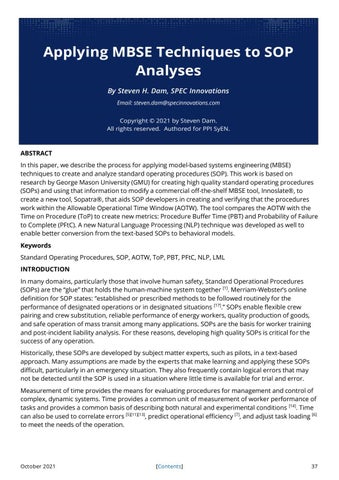Applying MBSE Techniques to SOP Analyses BySOP Steven H. Dam, Applying MBSE Techniques to Analysis
SPEC Innovations
Email: steven.dam@specinnovations.com
By Steven H. Dam
Copyright © 2021 by Steven Dam. All rights reserved. Authored for PPI SyEN.
ABSTRACT In this paper, we describe the process for applying model-based systems engineering (MBSE) techniques to create and analyze standard operating procedures (SOP). This work is based on research by George Mason University (GMU) for creating high quality standard operating procedures (SOPs) and using that information to modify a commercial off-the-shelf MBSE tool, Innoslate®, to create a new tool, Sopatra®, that aids SOP developers in creating and verifying that the procedures work within the Allowable Operational Time Window (AOTW). The tool compares the AOTW with the Time on Procedure (ToP) to create new metrics: Procedure Buffer Time (PBT) and Probability of Failure to Complete (PFtC). A new Natural Language Processing (NLP) technique was developed as well to enable better conversion from the text-based SOPs to behavioral models. Keywords Standard Operating Procedures, SOP, AOTW, ToP, PBT, PFtC, NLP, LML INTRODUCTION In many domains, particularly those that involve human safety, Standard Operational Procedures (SOPs) are the “glue” that holds the human-machine system together [1]. Merriam-Webster’s online definition for SOP states: “established or prescribed methods to be followed routinely for the performance of designated operations or in designated situations [17].” SOPs enable flexible crew pairing and crew substitution, reliable performance of energy workers, quality production of goods, and safe operation of mass transit among many applications. SOPs are the basis for worker training and post-incident liability analysis. For these reasons, developing high quality SOPs is critical for the success of any operation. Historically, these SOPs are developed by subject matter experts, such as pilots, in a text-based approach. Many assumptions are made by the experts that make learning and applying these SOPs difficult, particularly in an emergency situation. They also frequently contain logical errors that may not be detected until the SOP is used in a situation where little time is available for trial and error. Measurement of time provides the means for evaluating procedures for management and control of complex, dynamic systems. Time provides a common unit of measurement of worker performance of tasks and provides a common basis of describing both natural and experimental conditions [14]. Time can also be used to correlate errors [5][11][13], predict operational efficiency [7], and adjust task loading [6] to meet the needs of the operation.
October 2021
[Contents]
37




